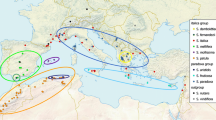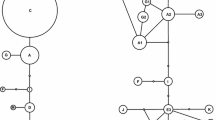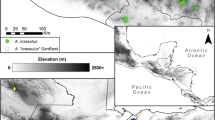Abstract
Relationships among Scorpidium cossonii and Scorpidium scorpioides haplotypes from most of the species’ distribution areas were analyzed based on ITS and rpl16. The haplotype networks were produced by TCS and were rooted by neighbor joining (ITS, recombination present) or maximum parsimony analysis. The haplotype closest to the root of the ITS network and some poorly represented haplotypes close to this have S. cossonii morphology and are arctic to subarctic, suggesting a northern origin of the complex. Additionally, two major lineages evolved from the root haplotype; one with S. cossonii morphology samples and one with all S. scorpioides morphology ones. The basal haplotypes in these major lineages include numerous temperate zone representatives, suggesting that adaptations for relatively warmer environments are present. Among haplotype groups that evolved later, one group in each major lineage is absent from America. rpl16 provides a scenario similar to that revealed by ITS for S. cossonii (no variation in S. scorpioides). Fossil and molecular evidence suggest that ancestral populations of S. cossonii evolved at least almost 4 Myr bp.








Similar content being viewed by others
References
Abbott RJ, Brochmann C (2003) History and evolution of the arctic flora: in the footsteps of Eric Hultén. Mol Ecol 12:299–313
Abbott RJ, Smith LC, Milne RI, Crawford RMM, Wolff K, Balfour J (2000) Molecular analysis of plant migration and refugia in the Arctic. Science 289:1343–1346
Alsos IG, Eidesen PB, Ehrich D, Skrede I, Westergaard K, Jacobsen GH, Landvik JY, Taberlet P, Brochmann C (2007) Frequent long-distance plant colonization in the changing Arctic. Science 316:1606–1609
Alsos IG, Engelskjön T, Gielly L, Taberlet P, Brochmann C (2005) Impact of ice ages on circumpolar molecular diversity: insights from an ecological key species. Mol Ecol 14:2739–2753
Bakker FT, Olsen JL, Stam WT (1995) Evolution of nuclear rDNA ITS sequences in the Cladophora albida/sericea clade (Chlorophyta). J Mol Evol 40:640–651
Bisang I, Hedenäs L (2005) Sex ratio patterns in dioicous bryophytes re-visited. J Bryol 27:207–219
Brochmann C, Brysting AK, Alsos IG, Borgen L, Grundt HH, Scheen A-C, Elven R (2004) Polyploidy in arctic plants. Biol J Linn Soc 82:521–536
Brochmann C, Gabrielsen TM, Nordal I, Landvik JY, Elven R (2003) Glacial survival or tabula rasa? The history of North Atlantic biota revisited. Taxon 52:417–450
Castelloe J, Templeton AR (1994) Root probabilities for infraspecific gene trees under neutral coalescent theory. Molec Phylog Evol 3:102–113
Clement M, Posada D, Crandall KA (2000) TCS: a computer program to estimate gene genealogies. Mol Ecol 9:1657–1659
Eidesen PB, Alsos IG, Popp M, Stensrud Ø, Suda J, Brochmann C (2007a) Nuclear vs. plastid data: complex Pleistocene history of a circumpolar key species. Mol Ecol 16:3902–3925
Eidesen PB, Carlsen T, Molau U, Brochmann C (2007b) Repeatedly out of Beringia: Cassiope tetragona embraces the Arctic. J Biogeogr 34:1559–1574
Elias SA, Matthews JV Jr (2002) Arctic North American seasonal temperatures from latest Miocene to the early Pleistocene, based on mutual climatic range analysis of fossil beetle assemblages. Can J Earth Sci 39:911–920
Fuertes E, Acón M, Oliván G (2005) Hamatocaulis y Scorpidium (Calliergonaceae, Bryopsida) en la Península Ibérica. Lazaroa 26:5–16
Goloboff PA (1993) Estimating character weights during tree search. Cladistics 9:83–91
Hassel K, Gunnarsson U (2003) The use of inter simple sequence repeats (ISSR) in bryophyte population studies. Lindbergia 28:152–157
Hedderson TA, Nowell TL (2006) Phylogeography of Homalothecium sericeum (Hedw.) Br. Eur.; toward a reconstruction of glacial survival and postglacial migration. J Bryol 28:283–292
Hedenäs L (1989) The genera Scorpidium and Hamatocaulis, gen. nov., in Northern Europe. Lindbergia 15:8–36
Hedenäs L (1994) Environments indicated by bryophytes in early Weichselian interstadial deposits from northern Sweden. Lindbergia 19:87–105
Hedenäs L (2003a) Amblystegiaceae (Musci). Fl Neotrop Monogr 89: i-iv, 1–107
Hedenäs L (2003b) The European species of the Calliergon–Scorpidium–Drepanocladus complex, including some related or similar species. Meylania 28:1–116
Hedenäs L (2008a) Molecular variation and speciation in Antitrichia curtipendula s. l. (Leucodontaceae, Bryophyta). Bot J Linn Soc 156:341–354
Hedenäs L (2008b) Molecular variation in Drepanocladus aduncus s.l. does not support recognition of more than one species in Europe. J Bryol 30:108–120
Hedenäs L, Eldenäs P (2007) Cryptic speciation, habitat differentiation, and geography in Hamatocaulis vernicosus (Calliergonaceae, Bryophyta). Plant Syst Evol 268:131–145
Hedenäs L, Eldenäs P (2008) Relationships in Scorpidium (Calliergonaceae, Bryophyta), especially between S. cossonii and S. scorpioides. Taxon 57:121–130
Hedenäs L, Oliván G, Eldenäs P (2005) Phylogeny of the Calliergonaceae (Bryophyta) based on molecular and morphological data. Plant Syst Evol 252:49–61
Hewitt G (2000) The genetic legacy of the Quaternary ice ages. Nature 405:907–913
Hewitt GM (2001) Speciation, hybrid zones and phylogeography—or seeing genes in space and time. Mol Ecol 10:537–549
Hewitt G (2004a) Genetic consequences of climatic oscillations in the Quaternary. Philos Trans R Soc B 359:183–195
Hewitt GM (2004b) The structure of biodiversity - insights from molecular phylogeography. Front Zool 1:4. doi:10.1186/1742-9994-1-4
Hey J, Wakeley J (1997) A coalescent estimator of the population recombination rate. Genetics 145:833–846
Ignatov MS, Afonina OM, Ignatova EA (2006) Check-list of mosses of East Europe and North Asia. Arctoa 15:1–130
Irwin DE (2002) Phylogeographic breaks without geographic barriers to gene flow. Evolution 56:2383–2394
Jansen E, Fronval T, Rack F, Channell JET (2000) Pliocene–Pleistocene ice rafting history and cyclicity in the Nordic Seas during the last 3.5 Myr. Paleoceanography 15:709–721
Jordan WC, Courtney MW, Neigel JE (1996) Low levels of infraspecific genetic variation at a rapidly evolving chloroplast DNA locus in North American Duckweeds (Lemnaceae). Amer J Bot 83:430–439
King RA, Ferris C (1998) Chloroplast DNA phylogeography of Alnus glutinosa (L.) Gaertn. Mol Ecol 7:1151–1161
Kuc M, Hills LV (1971) Fossil mosses, Beaufort Formation (Tertiary), northwestern Banks Island, western Canadian Arctic. Can J Bot 49:1089–1094
Laane MM, Croff BE, Wahlstrøm R (1983) Cytotype distribution in the Campanula rotundifolia complex in Norway, and cyto-morphological characteristics of diploid and tetraploid groups. Hereditas 99:21–48
Maslin MA, Haug GH, Sarnthein M, Tiedemann R (1996) The progressive intensification of northern hemisphere glaciation as seen from the North Pacific. Geol Rundsch 85:452–465
Matthews JV Jr, Ovenden LE (1990) Late tertiary plant macrofossils from localities in arctic/subarctic North America: a review of the data. Arctic 43:364–392
Mogensen GS (1981) The biological significance of morphological characters in bryophytes: the spore. Bryologist 84:187–207
Natcheva R, Cronberg N (2004) What do we know about hybridization among bryophytes in nature? Can J Bot 82:1687–1704
Newton AE, Wikström N, Bell N, Forrest LL, Ignatov MS (2007) Dating the diversification of the pleurocarpous mosses. Syst Assoc Spec Vol 71:337–366
Nuttall M, Callaghan TV (2000) The Arctic: environment, people, policy. Taylor & Francis, London
Randi E (2007) Phylogeography of South European mammals. In: Weiss S, Ferrand N (eds) Phylogeography of southern European refugia. Springer, Dordrecht, pp 101–126
Ray N, Adams JM (2001) A GIS-based vegetation map of the world at the last glacial maximum (25,000–15,000 BP). Intern Archaeol 11:1–44
Rydin C, Pedersen KR, Friis EM (2004) On the evolutionary history of Ephedra: Cretaceous fossils and extant molecules. Proc Natl Acad Sci 101:16571–16576
Sanderson MJ, Thorne JL, Wikström N, Bremer K (2004) Molecular evidence on plant divergence times. Amer J Bot 91:1656–1665
Schmitt T (2007) Molecular biogeography of Europe: Pleistocene cycles and postglacial trends. Front Zool 4:11. doi:10.1186/1742-9994-4-11
Schönswetter P, Paun O, Tribsch A, Niklfeld H (2003) Out of the Alps: colonization of northern Europe by east Alpine populations of the Glacier Buttercup Ranunculus glacialis L. (Ranunculaceae). Mol Ecol 12:3373–3381
Shaw AJ, McDaniel SF, Werner O, Ros RM (2002) New frontiers in bryology and lichenology. Phylogeography and phylodemography. Bryologist 105:373–383
Skrede I, Eidensen PB, Portela RP, Brochmann C (2006) Refugia, differentiation and postglacial migration in arctic-alpine Eurasia, exemplified by the mountain avens (Dryas octopetala L.). Mol Ecol 15:1827–1840
StatSoft I (2005) STATISTICA (data analysis software system), version 7.1. Tulsa. www.statsoft.com
Stewart JR, Lister AM (2001) Cryptic northern refugia and the origins of the modern biota. Trends Ecol Evol 16:608–613
Szövényi P, Hock Z, Urmi E, Schneller JJ (2006) Contrasting phylogeographic patterns in Sphagnum fimbriatum and Sphagnum squarrosum (Bryophyta, Sphagnopsida) in Europe. New Phytol 172:784–794
Taberlet P, Fumagalli L, Wust-Saucy A-G, Cosson J-F (1998) Comparative phylogeography and postglacial colonization routes in Europe. Mol Ecol 7:453–464
Thompson JD, Gibson TJ, Plewniak F, Jeanmougin F, Higgins DG (1997) The ClustalX windows interface: flexible strategies for multiple sequence alignment aided by quality analysis tools. Nucleic Acids Res 24:4876–4882
Vargas P (2003) Molecular evidence for multiple diversification patterns of alpine plants in Mediterranean Europe. Taxon 52:463–476
Weider LJ, Hobaek A (2000) Phylogeography and arctic biodiversity: a review. Annales Zoologici Fennici 37:217–231
Willis KJ, Niklas KJ (2004) The role of Quaternary environmental change in plant macroevolution: the exception or the rule? Philos Trans R Soc B 359:159–172
Acknowledgments
I thank M. Aronsson, I. Bisang, R. Eyrnaes, N. Hodgetts, D. T. Holyoak, K. Hylander, M. Ignatov, J. A Jansens, H. Köckinger, A. Kooijman, L. Miserere, J. P. Müller, C. Schubiger-Bossard, V. Spinas, S. Stofer, and E. Urmi for help in connection with fieldwork in various areas, or for sending me material included in the present study. I had excellent laboratory assistance from P. Eldenäs and K. Mirbakhsh. Comments from one reviewer improved several points in the paper. The curators of GOET, H, and TRH were very helpful with loans or during visits to the herbaria. The Swedish Research Council (Vetenskapsrådet project no. 621-2003-3338) supported this project.
Author information
Authors and Affiliations
Corresponding author
Rights and permissions
About this article
Cite this article
Hedenäs, L. Relationships among arctic and non-arctic haplotypes of the moss species Scorpidium cossonii and Scorpidium scorpioides (Calliergonaceae). Plant Syst Evol 277, 217–231 (2009). https://doi.org/10.1007/s00606-008-0131-y
Received:
Accepted:
Published:
Issue Date:
DOI: https://doi.org/10.1007/s00606-008-0131-y




